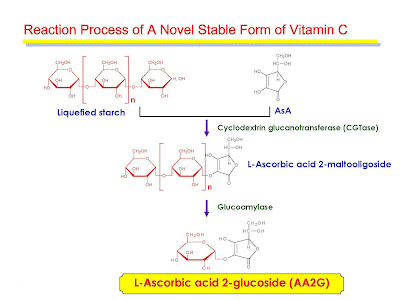AA2G is the stable C form which allows for a great deal of flexibility
when formulating. It is proven in clinical trials to be effective
antioxidant as well as up regulate collagen production.
L-Ascorbic acid functions in many biological processes i.e. anti-oxidation, collagen synthesis, intestinal absorption
of iron and amino acid metabolization . L-ascorbic acid is essential as a cofactor for the hydroxylation of proline and lysine residues in collagen, a major protein component of the body. LAA also increases transcription rate of procollagen genes and stabilizes procollagen mRNA. AA2G has proven to be effective at percentages as low as 2% . It is the extremely stable form of vitamin C
LAA is unstable and prone to oxidation in solution and only functional at pH below 3.5. AA2G is not limited by these requirements while delivering the same postive results as LAA.
AA2G is stable to air, heat , light and metal ions. It's range of formulation is greater than MAP and delivers greater dermal benefits than any other C derivative at present. It is convenient to formulate with.
The hydroxyl group of the second carbon in ascorbic acid is highly reactive and plays an important role in the natural biologic activity, however, it can also be the site of inactivation and decomposition.
Ascorbyl Glucoside is produced from vitamin C and starch by using a natural enzymes which result in binding glucose to the hydroxyl group of the same reactive carbon of the ascorbic acid.
An enzyme releases vitamin C at the cellular surface and provides benefits over a sustained period of time.
Ascorbyl Glucoside is hydrolyzed by glucosidase, an enzyme present in the membrane of skin cells.
This process releases vitamin C in its natural active form. When vitamin C enters cells it results in significant well-documented biological responses.
Ascorbyl Glucoside has been demonstrated to be hydrolyzed over a prolonged period giving its beneficial physiological effects to the cells and tissues in a constant and sustained manner.
Suppression of melanin synthesis:
When
Ascorbyl Glucoside is converted to vitamin C and enters the cells it significantly reduces the production of melanin by inhibiting tyrosinase activity. This results in a reduction of Dopaquinone, an intermediate of melanin synthesis. Additionally it converts existing Dopaquinone to L-Dopa.
Ascorbyl Glucoside bleaching of extant melanin:
When Ascorbyl Glucoside is converted to vitamin C and enters the cells it can significantly lighten existing black melanin by a reduction reaction.
Reduction in hyperpigmentation via AA2G topical application:
Creams containing Ascorbyl Glucoside are beneficial for lightening skin pigmentation.
Sixteen female volunteers (37 to 55 years old) applied a face cream containing 2% of AA2G™ twice a day to a hyperpigmented area of their face for a total of 90 days.The areas were matched against pantone color samples and the brightness (L* value) of the areas were measured by a colorimeter on day 0, 45 and 90. (*Significantly different from day 0 at <0.01)
Ascorbyl Glucoside suppresses cellular damage due to UV irradiation:
When
Ascorbyl Glucoside is converted to vitamin C it can dramatically reduce
the free radicals that result from UV irradiation of the skin, and
significantly reduce cell damage. Human skin fibroblasts were cultured for 1 day. Fibroblast samples were cultured a second day with or without 1mM AA2G™. The cells were irradiated with 20mJ/cm2 UVA and B radiation, and then cultured for 2 additional days.
The number of viable cells were determined. (*Significantly different from UV irradiated cells without AA2G™ at <0.05)

Ascorbyl Glucoside promotes collagen synthesis:
Collagen plays an important role in the structure and firmness of skin. Ascorbyl Glucoside is converted to vitamin C and promotes collagen synthesis of skin fibroblasts. Ascorbyl Glucoside maintains its effects for a sustained period of time, resulting in increasing benefits.
After cultivation of normal human skin fibroblasts for 1 day, the cells were cultured in the presence of vitamin C 0.2mM) or AA2G™ (0.2mM) for 2-4 days. The percentage of collagen to total protein was determined. (*Significantly different from control at p<0.05, and significantly different from vitamin C at p<0.05).
Ascorbyl Glucoside reduces wrinkles and roughness:
Products containing Ascorbyl Glucoside are highly beneficial for improving wrinkles and roughness of skin. Sixteen female volunteers (37 to 55 years old) applied a face cream containing 2% of AA2G™ twice a day for a total of 90 days to the outer corners of their eyes and cheek area. Silicone replicas of the corner of the eyes and the other treated areas were taken on days 0, 45 and 90 and wrinkle depth and skin roughness were measured by profilometry. (*Significantly different from day 0 at p<0.01)








